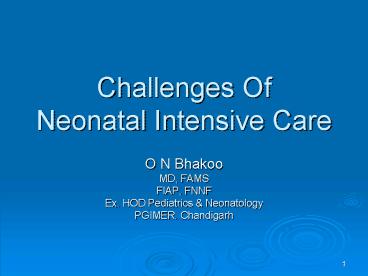Challenges Of Neonatal Intensive Care - PowerPoint PPT Presentation
1 / 14
Title:
Challenges Of Neonatal Intensive Care
Description:
Improving quality of Care. Reducing cost of Care. Enhancing Patient ... hematology * Drug Monitoring. D Pt Care Team * Neonatologist, Nurses ( 4:1 ) Resp. ... – PowerPoint PPT presentation
Number of Views:729
Avg rating:3.0/5.0
Title: Challenges Of Neonatal Intensive Care
1
Challenges Of Neonatal Intensive Care
- O N Bhakoo
- MD, FAMS
- FIAP, FNNF
- Ex. HOD Pediatrics Neonatology
- PGIMER. Chandigarh
2
Challenges OfNeonatal Intensive Care
- Normal Neonate
- High Risk Neonate
- Principals of Management
- Facilities required
- Improving quality of Care
- Reducing cost of Care
- Enhancing Patient Satisfaction
- Net working for neonatal care
- Summary
3
NORMAL NEONATE
- Born at full term
- Birth weight above 2.5 kg
- Appropriate wt for G.A.
- Free from perinatal complications (BA)
- Free from Cong. malformations
- Asymptomatic
- Normal vital signs.
- Needs ordinary care by the mother
- L- I Care
4
High Risk Neonates needing special care
- Level II SCBU / PMN
- LBW lt 2000gm.
- Preterm lt 34 wks.
- Moderate BA, HIE-1
- Moderately sick needing
- monitoring
- iv fluids, Oxygen,
- Phototherapy
- exchange transfusion
- Level III NICU
- VLBW lt 1500gm
- lt 32 wks.
- Severe BA HIE II or III
- Extremely sick with system failure.
- Needing-
- Intensive monitoring. Assisted ventilation.
- TPN.
- Post operative care.
5
Management Principals for HRBs
- Objective. Survival without brain damage
- Thermo neutral environment
- Adequate nutrition incl.TPN.
- Monitoring- Vitals, Oxygen, ventilation BP.
biochem. - parameters, drug level.
- Assisted Ventilation, Rx Shock. Renal failure
etc. - Preventing complications HAI, NEC,
Malnutrition, BPD, ROP, Deafness, Brain damage
6
Facilities required
- A- SPACE 50 sq ft./ Pt L- II Care
- 100sq ft./Pt L-
III - B EQUIPMENT
- - Electronic weighing scale one for each unit..
- - Open care system
- or baby incubator
- - Vital sign monitor L II gt
0.2 per bed - - BP monitor
- - Apnea monitor
- - FiO2 monitor
- -SaO2 monitor L- III
gt 1 per bed. - - Resusc Kit.
- - Infusion pump
- - Infant ventilator
7
Facilities Required / Equipment (cond 2)
- For Level- III Units Only
- Cold light source
- End tidal Co2 monitor monitors
- TcPO2 and TcPCO2 monitors
- ECG monitor with defibrillator
- Invasive BP monitor
- Intracranial pressure monitor
- ABG machine
- Portable X Ray Machine
- Portable Ultrasonography machine
8
Facilities Required- ( cont-3)
- C LABORATORY FACILITIES
- Microchemistry Microbiology
- hematology Drug Monitoring
- D Pt Care Team
- Neonatologist, Nurses ( 41 )
- Resp. therapist, Nutritionist,
- Physiotherapist, Biomed. Engineer
- Perinatologist, Ped.Surgeon.
- Ophthalmologist, Audiologist.
,Developmental Pediatrician
9
Facilities Required (cont. 4 )
- E - NEONATAL TRANSPORT-
- with facilities for
- Warming Transport Incubator
- Resuscitation and Asst. Ventilation
- ( portable ventilator)
- Monitoring
- Oxygen. Supply.
10
Improving Quality Of Care
- .1. HAI.-
- Protocols for infection control.
- Continuing audit for infection.
- Units antibiotic policy Review
- .2.- Ongoing audit of Pts medical and Nursing
records with spl. ref. to NEC,BPD. ROP, brain
hemorrhage from preventive point of view. - .3 Fatal outcome- Cause of death Lessons
- .4. Follow up of NICU survivors Protocols.
Neurodevelopment ROP, deafness. - .5. Compare your intact survival with other good
NICUS
11
Reducing cost of Care
- 1. Full utilization of facilities.
- - Equipment on rent / sharing with other
units - - Regionalization of Care
- 2. Shift to L- II care as soon as L- III care is
not required. - 3. Early discharge home Involve the mother in
care - 4. Reduce duration of hospitalization by
preventing factors which prolong hospital stay
eg. HAI, malnutrition, Ass. Ventilation. - 5. Health insurance for NIC.
12
Enhancing patient Satisfaction
- 1. High cost of care increases pt. expectations
and hence the accountability of care provider. - communication is the most sensitive aspect of
NIC. - 2. Keep family well informed about changing
condition of the pt. Possibility of compromised
outcome demands counseling truthfully yet with
sensitivity, compassion and guarded optimism - 3. Proper communication reduces the chances of
litigation. Always keep proper records about pt.
progress and the communications with the family.
13
Net working in NICU
- This involves Out- reach Education and
Regionalization of - neonatal care.-
- 1. Out reach education means need based
continuing education and training of the medical
staff of peripheral units from where pt. are
referred for L-III care. This is done by the
staff from L-III unit. - Topics of CME may be related to Cl. problem faced
during the preceding month. - 2. Regionalization means coordination of
neonatal care between - L-I, L II, L-III units in a small geographical
area with about 20,000 deliveries per year. This
system makes optimal utilisation of neonatal care
facilities. Where ever implemented, it has lead
to improved quality of care and reduced cost of
care.
14
Summary (Challenges of NICU)
- 1. NIC attempts to serve very sick and very small
neonates without brain
damage - 2. NIC. Involves elaborate and expensive
facilities and a dedicated team of
administrators, doctors, nurses and
technologists. - 3. The challenges of improving the quality of
care while keeping the cost affordable is not
insurmountable. Out of reach education and
Regionalization of care helps in achieving this
goal. - 4. Proper counseling of the family of a sick
neonate is a continuing learning experience.































